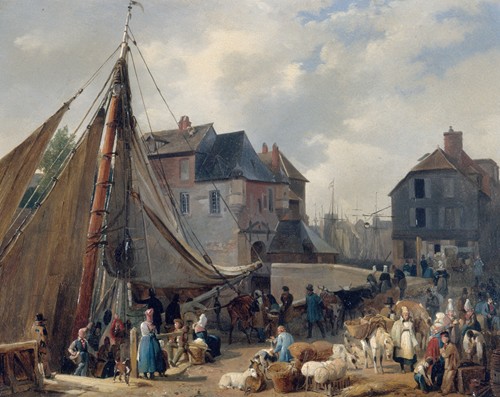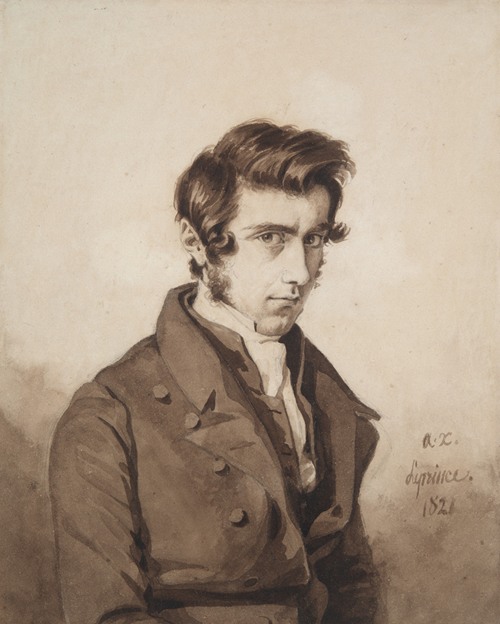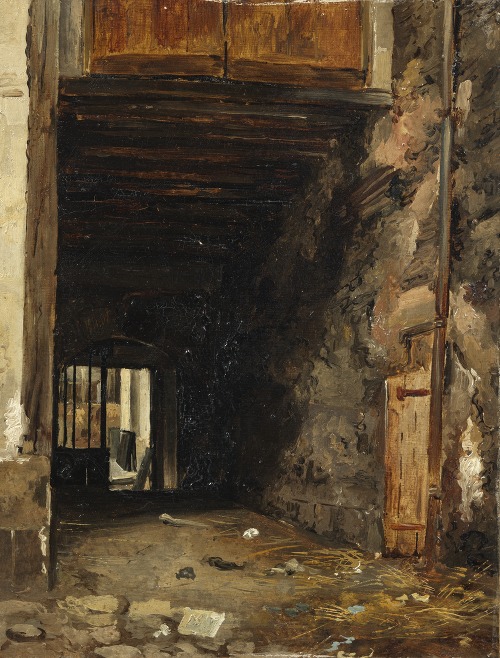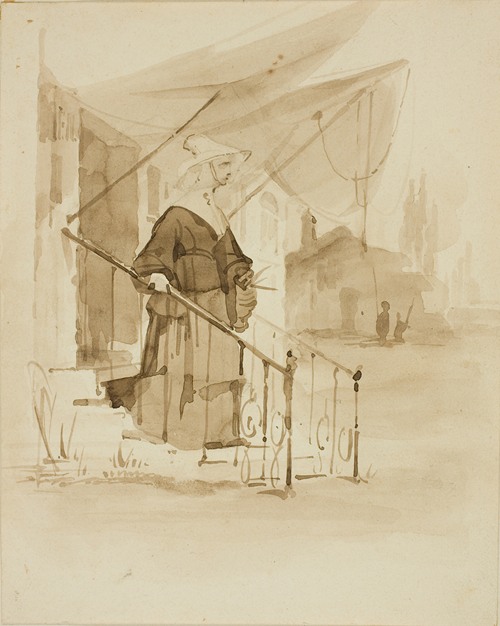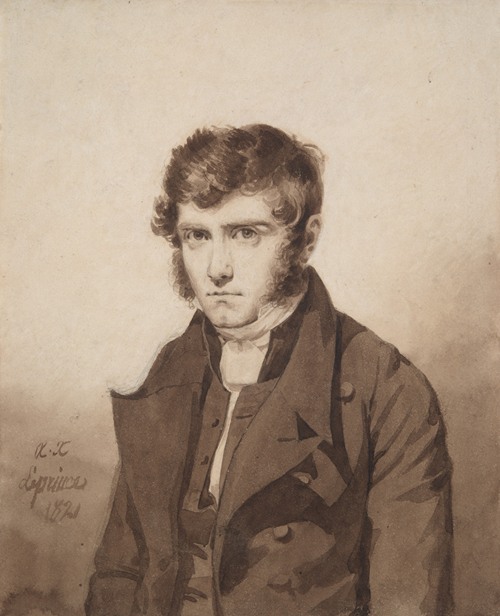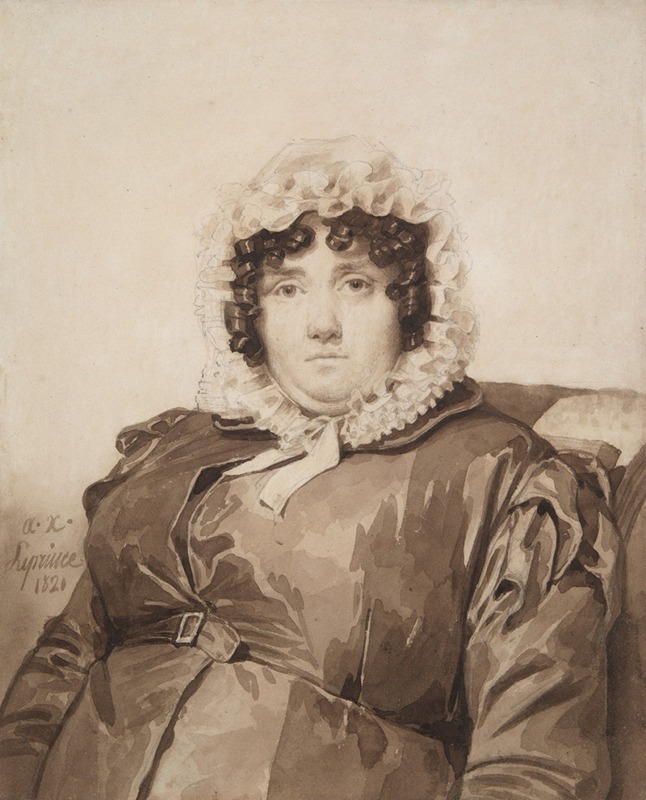
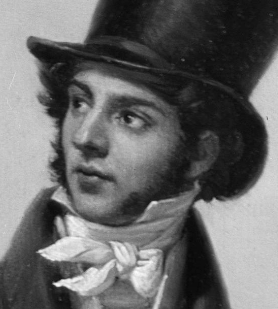
Auguste-Xavier Leprince was a French artist and painter who attained celebrity at the age of seventeen. His patrons included the Duchesse de Berry, Charles X, and Alexandre du Sommerard. He was also a teacher; in his twenties he established his own atelier in Paris, with pupils including his two younger brothers, Robert-Léopold and Pierre-Gustave, as well as Eugène Lepoittevin and Nicolas Alexandre Barbier. His meteoric career came to an abrupt end and his "brilliant promise was cut short by his premature death at the age of twenty-seven."
Xavier Leprince was born in Paris, the son of Anne-Pierre Leprince (said to be a painter and lithographer, but about whom little is known) and Marie-Adélaïde-Florentine Datir. Alexandre du Sommerard, who became one of his patrons, indicates that Xavier was essentially a self-taught artist, saying his early paintings were created "almost without any other guide than nature."
His earliest known works, dating from 1816 to 1819, mostly depict livestock and their keepers in pastoral settings. These precocious works gained for the teenaged Leprince "a celebrity confirmed by the exorbitant prices set, by the merchants themselves, for his first productions." Art historians see in these early works the influence of 17th-century Dutch landscape and animal painters Adriaen van de Velde, Adriaen van Ostade and Isaac van Ostade, and the French landscape artist Jean-Louis de Marne.
He made his salon debut at age nineteen, exhibiting six paintings, all landscapes or rural subjects, at the Paris Salon of 1819, where he was awarded a medal.
His expertise at depicting farming life in rural France reached a new level with his 1822 work La moisson, a painting of laborers harvesting a field, which was purchased by Marie-Caroline de Bourbon-Sicile, duchesse de Berry, who also collected Leprince's 1823 painting of ice-skaters, Les Patineurs. (She may also have commissioned from Leprince a painting depicting guests listening to music in her grove at the Hermitage of Enghien at Montmorency, known from a lithograph.)
His 1823 painting, Embarquement des bestiaux sur le Passager dans le port de Honfleur (Embarkation of Cattle on the Passager at the Port of Honfleur), emblematic of the cattle paintings of the era, was of singular importance to his career. Féréol Bonnemaison wrote that it "placed M. Leprince among our best genre painters. His career is now gloriously open before him." The painting was purchased by Charles X for 3,000 francs, and is now in the Louvre.
Moving beyond pastoral subjects, Leprince also painted marine art, scenes of Parisian life, works in the troubadour style, portraits, and the Forest of Fontainebleau, which had just begun to attract a new generation of French artists.
He also specialized in painting the human figures for a number of landscape painters, including Nicolas Alexandre Barbier, Étienne Bouhot, Alexandre-Hyacinthe Dunouy, André Giroux, Charles-Caïus Renoux, and Henri Édouard Truchot.
Leprince's skill at figure painting was appreciated by Corot, and Vincent Pomarède speculates that Corot was influenced by Leprince.
Works such as the watercolor A Ceremony on the Capitoline Hill in Rome, dated 1821, provide evidence of travel to Italy.
In 1822, from the Société des Amis des Arts, Leprince received a commission to commemorate the valiant efforts of French doctors and nuns who had traveled to Barcelona in response to an epidemic of yellow fever, which killed an estimated 20,000 inhabitants. The resulting painting was an ambitious panorama with more than forty figures, variously called Peste de Barcelone or Les Médecins français et les Sœurs de Saint-Camille à Barcelone. La Nouveauté called it a "very remarkable" work "which announced a very distinguished talent." The painting was praised and minutely described by Charles Paul Landon in a volume of his Annales du Musée et de l'École moderne des beaux-arts, which included a fold-out reproduction, currently the only known image of Leprince’s painting.
In 1824, inspired to paint the coast of Normandy, Leprince began sharing a studio with Eugène Isabey at Honfleur.
By 1822, the year Leprince turned 23, his talents as a painter had attracted the patronage of the antiquarian Alexandre du Sommerard, whose collection of medieval art and artifacts would become the Musée de Cluny. Du Sommerard included lithographs of four works by Leprince in his highly influential Vues de Provins, which also included four works by Xavier's younger brother, Léopold Leprince. The book, an illustrated tour of medieval churches and abbeys, many of them reduced to ruins in the violence of the French Revolution, was part of an artistic and literary movement, the troubadour style, that romanticized the Middle Ages in France. About Leprince's Vue de la partie des fortifications dite le Trou du Chat, the art historian Pierre Bénard writes, "Is there not something Virgilian in the peaceful herd immortalized by Xavier Leprince at the foot of a tower of the ramparts?"
At the Paris Salon of 1824, Leprince exhibited a full-length portrait of his patron, listed in the catalogue as Portrait en pied de M. du S… dans son cabinet. Its location is unknown.
At the time of his death, Leprince left unfinished two paintings commissioned by du Sommerard. One was The Artist's Studio. The other was a portrait of du Sommerard conferring with a Jewish antiques dealer and surrounded by prized artifacts from his collection, entitled L’Antiquaire (The Antiquarian). To complete the portrait, du Sommerard commissioned another of his protégés, Charles-Caïus Renoux, who did so "with rare talent." It was displayed in the Paris Salon of 1827. A contemporary reviewer noted that "at the time of Xavier Leprince's death, the two figures alone were made, and the rest was hardly sketched out. It is M. Renoux who was commissioned to complete this interior," consisting of furniture, armor, and numerous objets d'art from the Middle Ages; "finally everything comes together to make this painting a precious piece." The contemporary critic Auguste Jal declared the painting "a perfect work." L’Antiquaire has been cited by modern scholars researching the history of antiquarianism and the invention of the modern museum.
With the publication of Inconvéniens d'un Voyage en Diligence, and his work on major commissions from du Sommerard, 1826 was a busy and productive year for Leprince, but at some point he became ill. When the condition lingered and his health deteriorated, doctors advised a move to a milder climate; Leprince went with his father to Nice. "We had conceived the hope that the beautiful sky in the south of France would restore him to health; but this hope has been deceived!" lamented Féréol Bonnemaison.
The symptoms and attempted cure suggest tuberculosis. Bonnemaison calls it a "long-lasting pulmonary condition." Du Sommerard describes "a chest condition" and a "long agony," and the attempted cure: "he was forced, according to the opinion of the doctors, to tear himself away, a few months ago…to go and expire in a foreign place, in that privileged climate which a barbaric routine and, often, an even more barbaric sensibility unnecessarily assign as a resource to our patients, for whom it almost always becomes the tomb."
On the day after Christmas, 1826, Xavier Leprince died in Nice. "His last sighs were received by his father, whom no consideration, even that of serious infirmities, could separate from his son, until the fatal event which brought him back alone."
